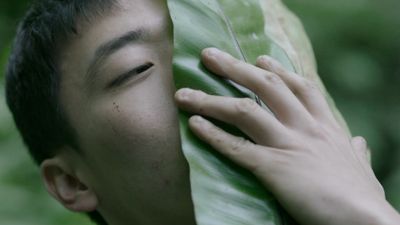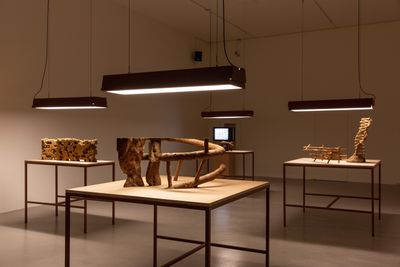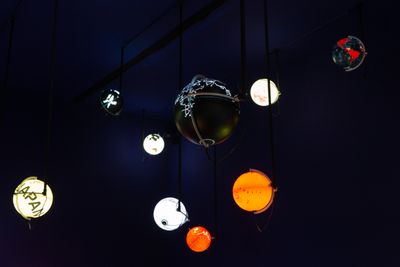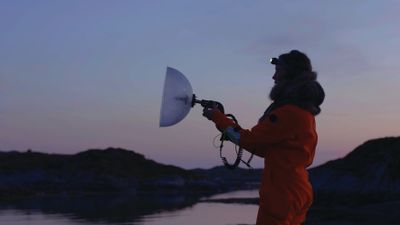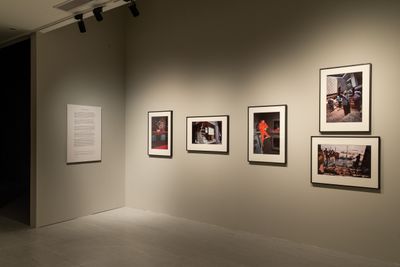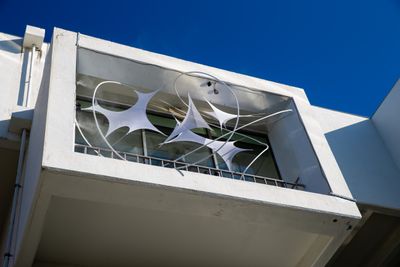11th Taipei Biennial: ‘creativity and crises’
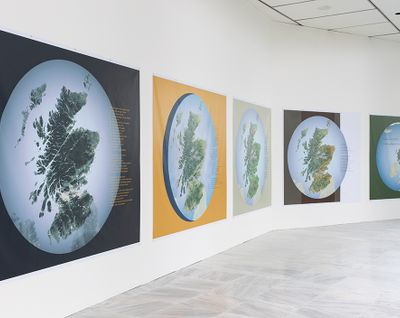
Helen Mayer Harrison & Newton Harrison, On the Deep Wealth of this Nation (2018). Vinyl and print. 221 × 213–280 cm. Exhibition view: Post-Nature—A Museum as an Ecosystem, 11th Taipei Biennial, Taipei Fine Arts Museum (17 November 2018–10 March 2019). Courtesy © the artist and Taipei Fine Arts Museum.
Stealthily installed in the basement of the Taipei Fine Arts Museum as part of Post Nature—A Museum as an Ecosystem, the 11th Taipei Biennial co-curated by Mali Wu and Francesco Manacorda (17 November 2018–10 March 2019), are Pteridophilia 1, 2, and 3 (2016–2018), an erotically charged series of videos by Beijing-born and Hong Kong-based artist Zheng Bo. 'Pteridophilia' is inspired by the move many Japanese artists made to Taiwan in the early 20th century, some of whom were seduced by the island's luscious tropical flowers. Obliquely drawing on Taiwan's colonial past, Zheng Bo's films depict naked young men interacting with ferns in a forest; fondling, rubbing, touching, licking, and caressing leaves.
While the work's title, composed from the ancient Greek 'pterido' (fern) and 'philia' (love), refers to the love and lust between humans and plants, 'Pteridophilia' is also an examination of power, control, and submission, evoking forbidden textures, aromas, and pleasures. (Ferns are abundant in Taiwan and have been cherished by Indigenous peoples but overlooked by Japanese colonialists and immigrants from the mainland.) At the same time, in the context of this exhibition, the videos connect with global concerns surrounding the co-existence between humans and nature: a fitting lynchpin for the theme of this Biennial, which synergises with that of Manifesta 12 in Palermo, The Planetary Garden. Cultivating Coexistence (16 June–4 November 2018), where 'Pteridophilia' was recently shown. Both biennials deploy nature as a metaphor for the precariousness of our contemporary ecosystem and the role of adaption and coexistence.
Presented throughout the Taipei Fine Arts Museum, the 11th Taipei Biennial makes use of every aspect of the museum's architecture, expanding into the basement with installations and videos. In addition, walkways, foyers, and outdoor courtyards are utilised to present an array of existing work and new commissions by 42 artists and collectives from 19 countries and territories, including Candice Lin, Chin-Yuan Ke, Rachel Sussman, Vivian Suter, and Robert Zhao Renhui. The exhibition's capacious title is ushered in by a gigantic, local tree suspended upside down from a mirrored ceiling, abundantly occupying the museum's entrance foyer: Inverted Tree (Reflected) (2018) by Swedish artist Henrik Håkansson. This impressive installation offers a succinct starting point by bringing nature into the museum in an imposing and experimental way, while articulating the inversion of the natural world outside with the interior world of the museum.
This gesture of encounter is also reflected by the appointment of its two curators. Francesco Manacorda is currently artistic director of the V-A-C Foundation in Moscow, and previously served as curator at the Barbican Art Gallery (2007–2009) where he realised the large-scale exhibition Radical Nature – Art and Architecture for a Changing Planet 1969–2009 (2009), which could be seen as a prelude to the Taipei Biennial. Mali Wu is a participatory and community-based Taiwanese artist, and a lecturer at the Graduate Institute of Interdisciplinary Art at National Kaohsiung Normal University. Notably, she has led projects in Plum Tree Valley, of New Taipei City's Zhuwei area, which re-examined urban ecology and development through a neglected creek, consistently exploring ecological issues.
While the Taipei Biennial's previous three iterations were orchestrated by single curators, this structure of a duo or collaborative one-to-one model allows for multiple perspectives and confluences across disciplines and knowledge frameworks, without being too dispersed, as is the case with larger curatorial frameworks (such as the 12th Gwangju Biennale). Together, Manacorda and Wu explore the museum as a cross-disciplinary enterprise by exhibiting activist participants, sometimes in collaboration with artists, including Huai-Wen Chang & MAS (Micro Architecture Studio) and Chu-Yin Chen & Solar Insects Vivarium Workshop, to focus on the interconnectivity of ecosystems, social experimentation, and interdisciplinary possibilities.
Encapsulating this exhibition's curatorial theme in symbolic form is Termite Economics (2018), by Nicholas Mangan: an ensemble of termite habitats rendered via 3D modelling in plaster, dirt, synthetic polymer paint, and plywood that appear like entangled mounds, complete with chambers and pathways, laid out forensically on tables like specimens on display in one room.
The installation also comprises drone footage that Mangan commissioned in Western Australia offering the imaginary perspective of a termite approaching these mounds in an arid landscape—a reference to the research on which this project is based: a Commonwealth Scientific and Industrial Research Organization (CSIRO) investigation into the use of termites to locate rare earth minerals. Mangan deploys the CSIRO research as an allegory for social hierarchies and ecosystems of labour in order to explore notions of swarm intelligence and how termites build sophisticated architectures. n doing so, Mangan considers termites as miners and world-builders that offer insight into the social and economic structures humans tend to build thereby reflecting on insects as a microcosm of human behaviours.
Dioramas, habitats and simulated environments surface throughout this show, with biospheres, specimens, and cosmologies converging to depict at once a fragile world in disarray and the complexity of coexistence and worldmaking. For example, artist and journalist Ingo Günther's Worldprocessor (1988–ongoing), is an atlas of illuminated globes that map data across coloured spheres such as health statistics, birth rates, military expenditure, and drug routes. This constellation of luminous globes forecasts and extrapolates data onto spherical readymades, strung up in a darkened room like floating orbs.
Strongly visual, Worldprocessor is conceptual, scientific, and analytical, alluding to structures formed between humans and nature, which is the backbone of the exhibition. The curatorial statement articulates an intention to 'explore, illustrate and investigate the different modes of connectivity and reciprocal dependency that keep a system alive'.
Ecological interdependency is highlighted in Ursula Biemann's Acoustic Ocean (2018): a beautiful video essay of oceanic depths and interspecies relations above and below the waterline of the Lofoten Islands in Northern Norway. The film draws on the tropes of science fiction with a central, female protagonist in an orange suit seen placing instruments along the shore in order to detect and connect with the acoustic world of the ocean. The aquanaut character is played by singer and environmental activist Sofia Jannok, who recounts the effects of a shifting climate on the indigenous Sami community and the reindeer on which their economic and cultural sovereignty rely.
The ocean is a reference in a number of other works, with the late American photographer Allan Sekula's visual essay Fish Story (1989–1995) casting an arc back to a seven-year photographic essay detailing international maritime ports, from New York to Ulsan. Conceived as an exhibition and a book, this landmark body of work, considered Sekula's magnum opus, is divided into seven chapters that speculate on global capitalism. It is presented here as a suite of colour photographs and slide projections, and in many ways sits at the heart of the Biennial. Setting the scene for ensuing political, social, and cultural crises are documents of explosions amid the transportation of goods—dauntingly bleak depictions of maritime subcultures and their associated economies.
The realities of the Anthropocene hover throughout this show, signalling the human impact on the earth's geology and ecosystems as one of the most urgent issues (and catastrophes) of our times. Thai artist Ruangsak Anuwatwimon's Anthropocene (2018) constitutes 20 blocks of polluted soil collected from sites across Taiwan, dispersed across one gallery floor. Micro Architecture Studio's exhibition within an exhibition of drawings, models, and propositions for climate data improvement in Mas Biennial (2014–2018), for instance, and the lectures, tours, and forums as part of the Biennial's 'Ecolab' platform delve into ecological narratives, including a forum on 'The Art of Recyclism, E-waste Cultures' (28 November 2018) and a workshop titled 'From Weeds to a Pot of Tea' (25 November 2018), which highlight the environmental havoc created by humans on the planet.
At times didactic and instructive, these inclusions provide factual documentation that harnesses the exhibition's central tenet, while also responding to the question the curatorial statement poses about 'how an ecosystem is generated' and revived through collaboration and adaptation.
Wu and Manacorda skilfully navigate this question of collaboration by including projects undertaken by activist enterprises (Keelong River Watch Union's guided cultural outings that protect the ecosystem of Taipei's rivers); socially engaged initiatives (including Jui-Kuang Chao & Tainan Community University's Taiwan Zhi Zui, 2018); architectural labs (Huai-Wen Chang & MAS, Micro Architecture Studio's rooftop weather station), thus creating a cross-disciplinary platform of networks.
Augmenting this curatorial project was a mini-symposium held on 17 November that investigated sub-themes including 'Re-naturalising Citizenship' and 'Democratising Boundaries', with keynote speaker Chun-Mei Chuang, a sociology professor at Soochow University in Suzhou, China. Another series of talks is set for 15 and 16 December; scheduled presentations include 'The Oceanic—a Voyage into the Geopolitical and Biophysical of the Pacific' by Ute Meta Bauer, director of NTU Centre for Contemporary Art Singapore.
While a printed catalogue didn't accompany the exhibition, a guide with individual entries for each artist and floor maps was available for download in English and Chinese with a preface by the museum's director, Lin Ping, and an unattributed introduction, which outlines the curatorial rationale for the Taipei Biennial. More in-depth contributions from a variety of cross-disciplinary essayists would have harnessed the exhibition's prescient theme, including keynote speaker, Rwandan-born Dutch artist and author Christian Nyampeta's ongoing reflections on co-existence and living together.
At times, it is unclear how the museum's ecosystem has been co-opted for osmosis and growth, yet overall the 11th Taipei Biennial is a capacious and holistic platform for interconnectivity between habitats, artworks, and activist preoccupations. Wu and Manacorda's visual and environmental biennial is profoundly poetic, reminding us how creativity and crises can coalesce. —[O]

